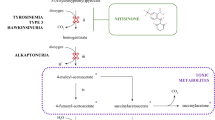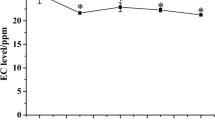Abstract
Objective
To investigate the antipyretic mechanism of Herba Ephedrae (Eph)-Ramulus Cinnamomi (RC) herb pair on yeast-induced pyrexia in rats.
Methods
Totally 30 qualified male SD rats were randomly assigned to the normal control (NC) group, the pyrexia model (model) group, the Eph, RC and Eph-RC treatment groups by a random digital table, 6 rats in each group. Each rat received a 20% aqueous suspension of yeast (10 mL/kg) except the NC group. The 3 treatment groups were administered 8.1, 5.4 and 13.5 g/kg Eph, RC and Eph-RC respectively at 5 and 12 h after yeast injection, the NC group and the model groups were administered equal volume of distilled water. Rectal temperatures were measured at 0, 6, 8, 10, 12, 15, 18, 24 and 30 h and urine was collected prior to yeast injection and at 6, 10, 18, 24, 30, and 36 h after yeast injection. Then urine metabolomic profiling by gas chromatography tandem mass spectrometry, coupled with multivariate statistical analysis and pattern recognition techniques were used to explore the antipyretic effects of Eph-RC. Partial least squares discriminate analysis was used to analyze the metabolomics dataset including classification and regression in metabolomics plot profiling.
Results
Compared with the NC group, rectal temperatures were significantly higher in the model group (P<0.01), while 3 treatment groups decreased significantly compared with the model group (P<0.05 or P<0.01). Rectal temperatures of Eph-RC-treated rats started to go down at 6 h, and markedly decreased at 8, 12, 15, 18 and 24 h (P<0.05 or P<0.01), while those of the Eph and RC groups had decreased firstly at 8 h and were markedly lower at 12 h (P<0.05 or P<0.01). Seventeen potential biomarkers related to pyrexia were confirmed and identified, including pyruvic acid, L-phenylalanine, L-tyrosine, phenylacetic acid, hippuric acid, succinic acid, citrate and so on. Eight potential alterations of metabolic pathways including phenylalanine metabolism, citrate cycle, tryptophan metabolism, biosynthesis of valine, leucine and isoleucine, were identified in relation to the antipyretic effects of Eph-RC using MetPA software.
Conclusion
The antipyretic effect of Eph-RC herb pair on yeast-induced pyrexia in rats involved correction of perturbed amino acid, fatty acid, and carbohydrate metabolism according to the metabolic pathway analysis with MetPA.
Similar content being viewed by others
References
Mackowiak PA, ed. Mandell, Douglas, and Bennett’s principles and practise of infectious disease. 6th ed. Philadelphia: Natasha Andjelkovic Publishing House; 2005:703–718.
Mei F, Xing XX, Tang QF, Chen FL, Guo Y, Song S, et al. Antipyretic and anti–asthmatic activities of traditional Chinese herb–pairs, Ephedra and Gypsum. Chin J Integr Med 2016;22:445–450.
Xie XH, Dong J, Fu YM, Tang HM. Study on antipyretic effect and mechanism of Fructus Lonicerae on IL–1β–induced fever in rabbits. Lishizhen Med Mater Med Res (Chin) 2007;18:2071–2073.
Huang L, Liu JF, Liu LX, Li DF, Zhang Y, Nui HZ, et al. Studies on the antipyretic and anti–inflammatory effects of Artemisia annua L. Chin J Chin Mater Med (Chin) 1993;18:44–48.
He Y, Zhu Y, Zhang R, Ge L, Wan H. Simultaneous quantification of nine major active components in traditional Chinese prescription Mahuang decoction and the influence of herbal compatibility on their contents. Pharmacogn Mag 2014;10:S72–S79.
Wang JB, Li ZY, Wang XH. Clinical application of Ephedra decoction. Chin J Ethnomed Ethnopham (Chin) 2011;10:57–58.
Wu GR, Wang XW. The pharmaceutical study of pseudophedrine salicylate () antipyretic–action and the effects on heart rate, blood pressure and histamine–induced allergic reations. Prog Pharm Sci (Chin) 2000;24:238–241.
Ge W, Li HB, Yu Y, Fang B, Yao XS. Research progress on chemical constituents, pharmacological action, and clinical application of reduning injection. Chin Tradit Herb Drugs (Chin) 2017;48:1027–1036.
Zhang LQ, Zhang ZG, Fu Y, Xu Y. Research progress of trans–cinnamaldehyde pharmacological effects. Chin J New Drugs (Chin) 2015;40:4568–4572.
Xie B, Gong T, Gao R, Liu J, Zuo J, Wang X, et al. Development of rat urinary HPLC–UV profiling for metabolomics study on Liuwei Dihuang Pills. J Pharm Biomed Anal 2009;49:492–497.
Gavaghan CL, Nicholson JK, Connor SC, Wilson ID, Wright B, Holmes E. Directly coupled high–performance liquid chromatography and nuclear magnetic resonance spectroscopic with chemometric studies on metabolic variation in Sprague–Dawley rats. Anal Biochem 2001;291:245–252.
Wang XJ, Sun H, Zhang AH, Sun WJ, Wang P, Wang ZG. Potential role of metabolomics approaches in the area of traditional Chinese medicine: as pillars of the bridge between Chinese and Western medicine. J Pharm Biomed Anal 2011;55:859–868.
Gao P, Lu C, Zhang F, Sang P, Yang D, Li X, et al. Integrated GC–MS and LC–MS plasma metabonomics analysis of ankylosing spondylitis. Analyst 2008;133:1214–1220.
Hong Z, Lin Z, Liu Y, Tan G, Lou Z, Zhu Z, et al. Innovative microwave–assisted oximation and silylation procedures for metabolomics analysis of plasma samples using gas chromatography–mass spectrometry. J Chromatogr A 2012;1254:14–22.
Gu Q, David F, Lynen F, Rumpel K, Dugardeyn J, van Der Straeten D, et al. Evaluation of automated sample preparation, retention time locked gas chromatography–mass spectrometry and data analysis methods for the metabolomic study of Arabidopsis species. J Chromatogr A 2011;1218:3247–3254.
Xu WJ, Fang F, Yu LZ, Luo JB. Studies on antipyretic activity and Its mechanisms of couplet medicines of Herba Ephedrae and Ramulus Cinnamomi. Lishizhen Med Mater Med Res (Chin) 2013;24:1547–1549.
Namera A, Yashiki M, Nishida M, Kojima T. Direct extract derivatization for determination of amino acids in human urine by gas chromatography and mass spectrometry. J Chromatogr B 2002;776:49–55.
Huo HR, Tan YQ, Qin CL, Liu T. Effect of Guizhi Decoction on complex pathologic model of spontaneous hypertension with hyperpyxia of rat induced by yeast. Chin J Exp Tradit Med Form (Chin) 2004;10:37–39.
Broadley KJ. The vascular effects of trace amines and amphetamines. Pharmacol Ther 2010;125:363–375.
Lindemann L, Hoener MC. A renaissance in trace amines inspired by a novel GPCR family. Trends Pharmacol 2005;26:274–281.
Wang X, Li J, Dong G, Yue J. The endogenous substrates of brain CYP2D. Eur J Pharmacol 2014;724:211–218.
Gao XY, Guo MX, Peng L, Zhao BS, Su JK, Liu HY. UPLC Q–TOF/MS–based metabolic profiling of urine reveals the novel antipyretic mechanisms of Qingkailing Injection in a rat model of yeast–induced pyrexia. Evid Based Complement Alternat Med 2013;2013:864747.
Israel G, Stefan RJ, Ophry P. Organic acids: old metabolites, new themes. J Chem Technol Biotechnol 2006;81:1601–1611.
O’Mahony SM, Clarke G, Borre YE, Dinan TG, Cryan JF. Serotonin, tryptophan metabolism and the brain–gutmicrobiome axis. Behav Brain Res 2015;277:32–48.
Author information
Authors and Affiliations
Corresponding author
Additional information
Supported by the National Natural Science Foundation of China (No. 81030066)
Electronic supplementary material
Rights and permissions
About this article
Cite this article
Wang, Xm., Xu, Wj., Xu, Lk. et al. Antipyretic Effect of Herba Ephedrae-Ramulus Cinnamomi Herb Pair on Yeast-Induced Pyrexia Rats: A Metabolomics Study. Chin. J. Integr. Med. 24, 676–682 (2018). https://doi.org/10.1007/s11655-017-2778-0
Accepted:
Published:
Issue Date:
DOI: https://doi.org/10.1007/s11655-017-2778-0




